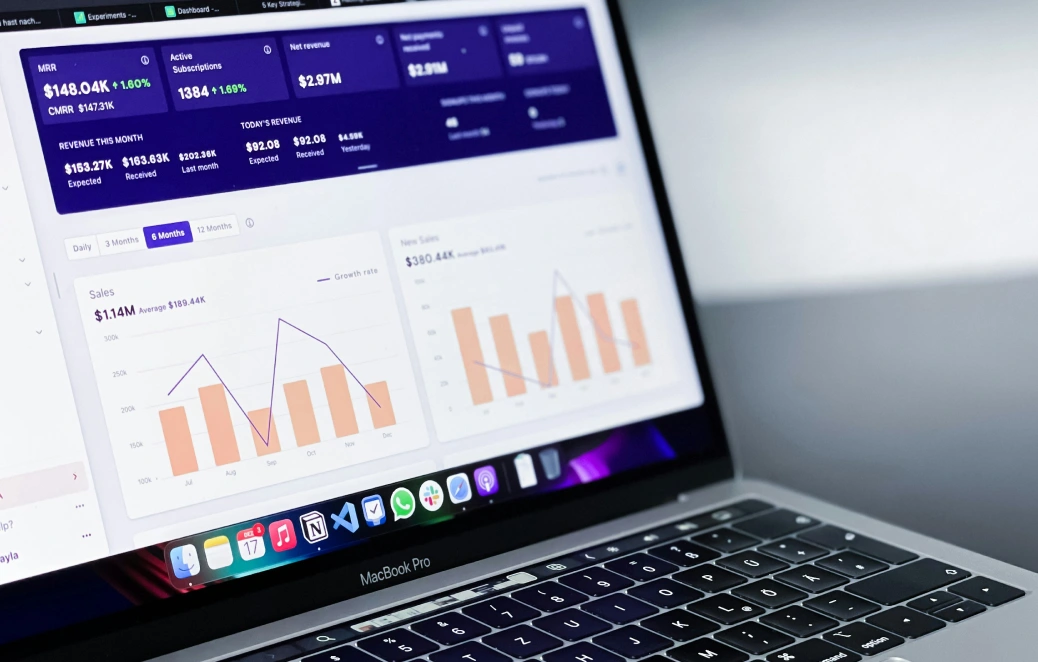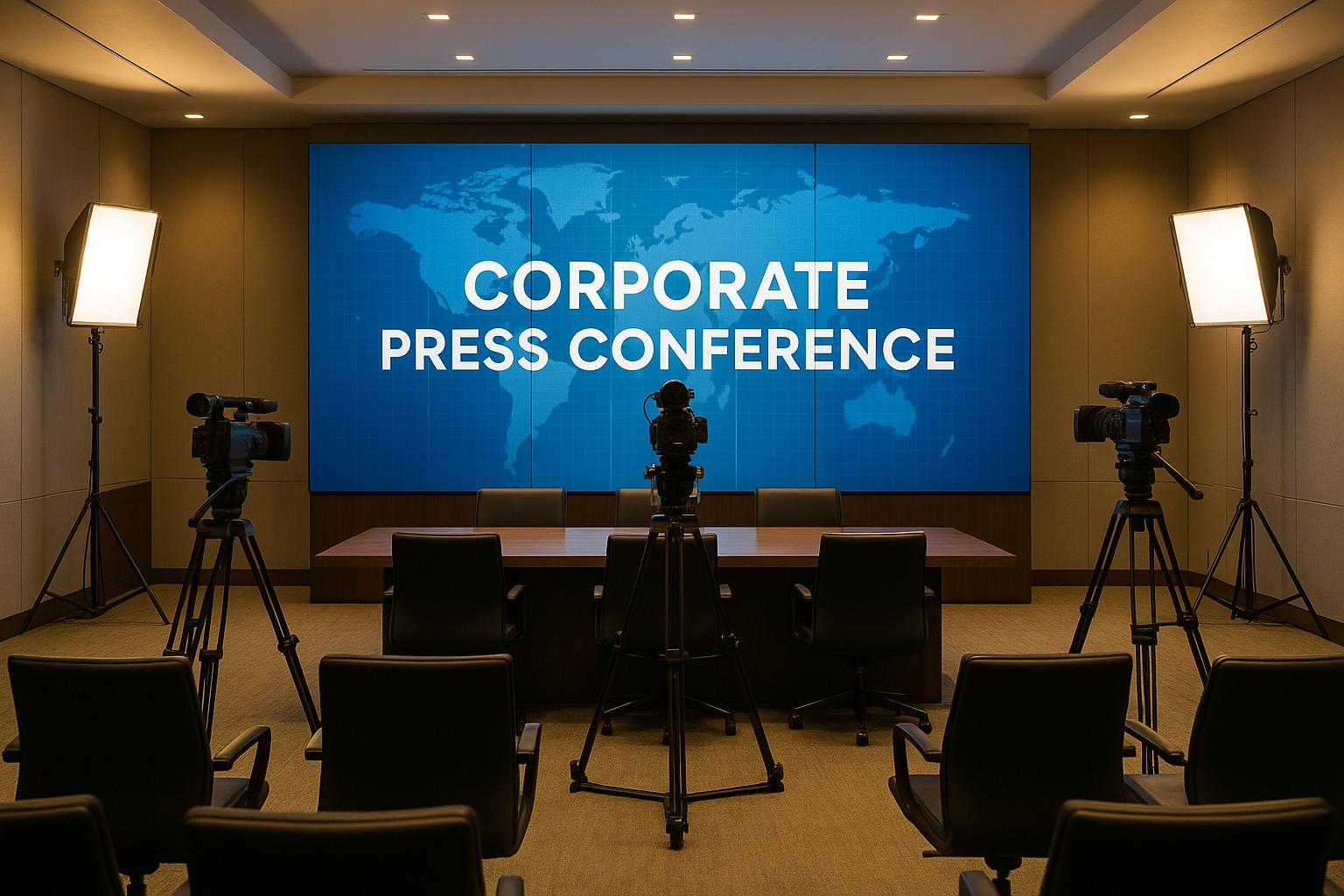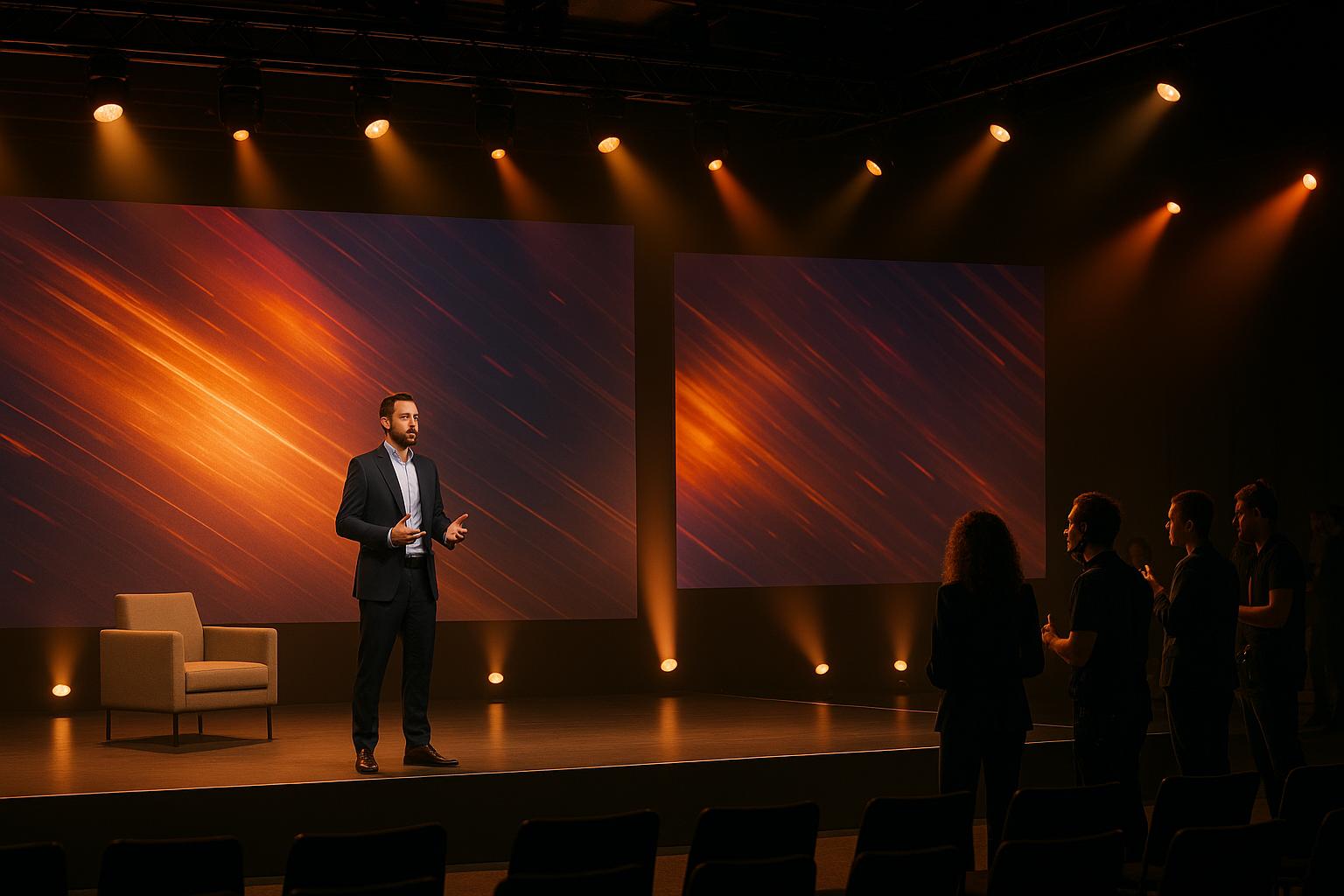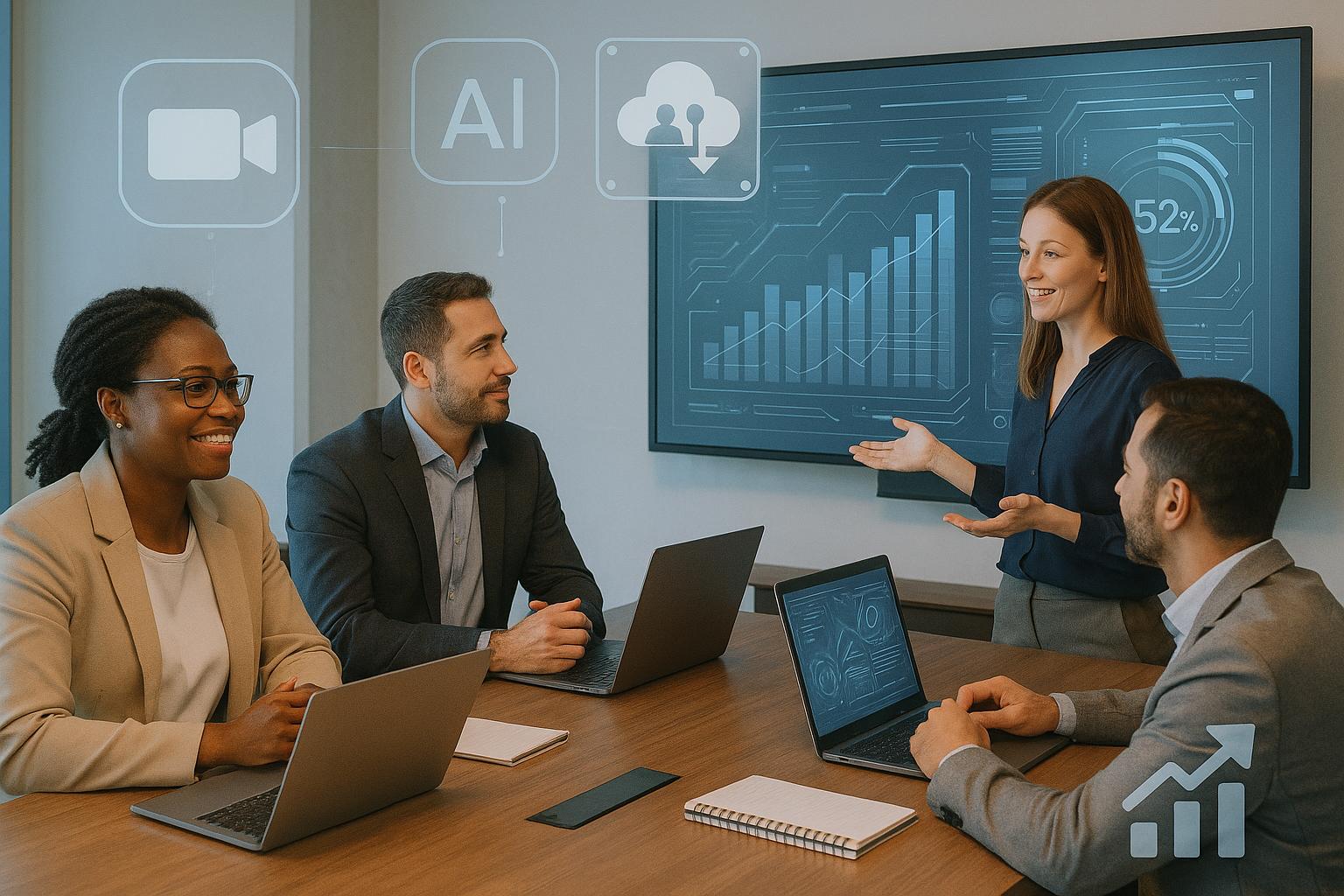5 Best Practices for Annual Conferene Planning & Production

Chief Executive Officer
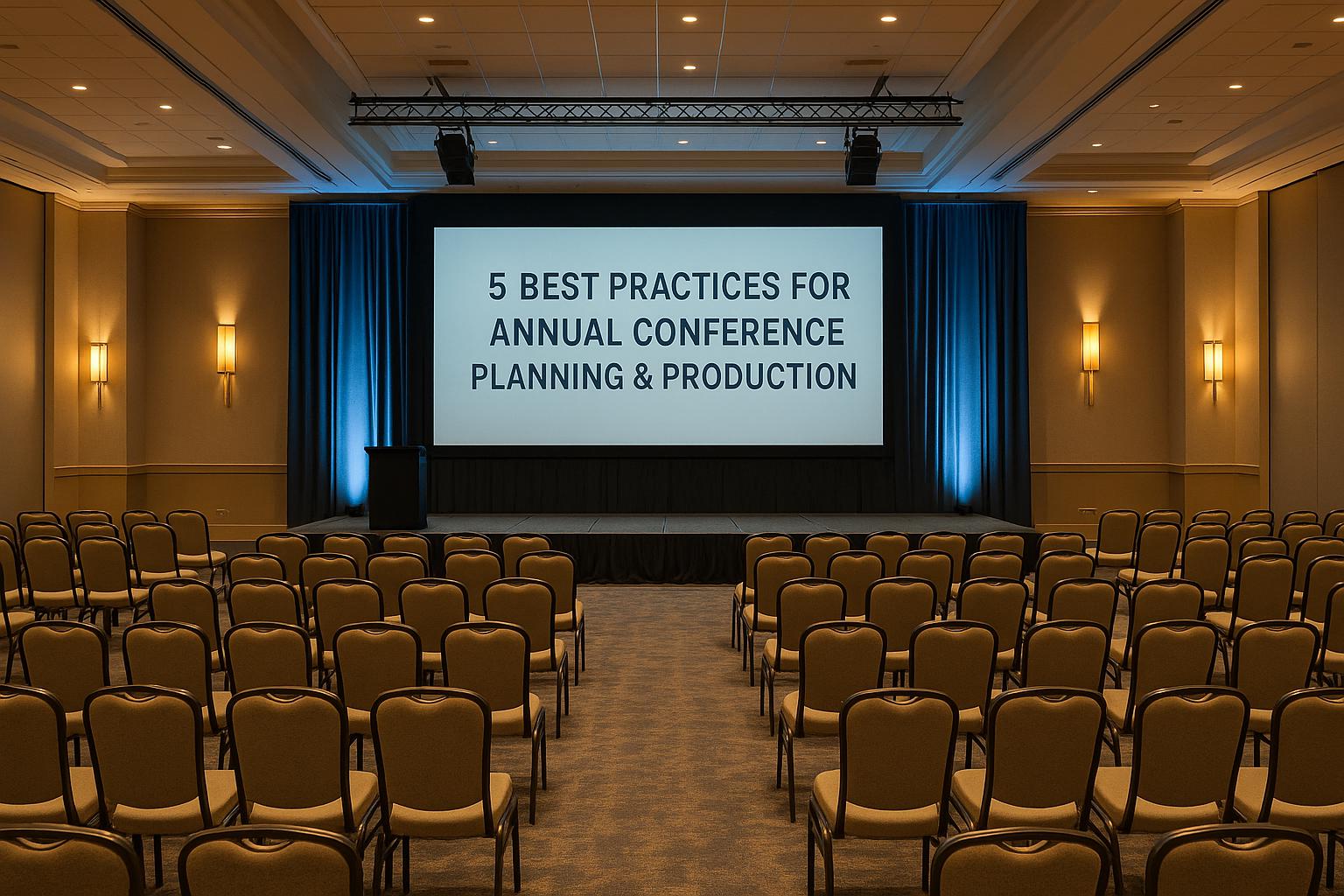
Annual conferences can either be a forgettable gathering or a powerful event that drives business outcomes. To ensure success, focus on these five key areas:
- Leverage Advanced Audiovisual Technology: Use high-quality AV tools like HD cameras, dynamic lighting, and interactive platforms to create immersive experiences for both in-person and virtual attendees. Partnering with professional AV teams ensures seamless execution.
- Create a Detailed Production Timeline: Map out every step, from venue booking to post-event analysis, with clear deadlines and milestones. Use project management tools like Gantt charts to stay organized and on track.
- Choose the Right Venue: Evaluate venues based on technical requirements, budget, and accessibility. Plan logistics like vendor coordination, security, and contingency strategies to ensure smooth on-site operations.
- Boost Audience Engagement with Technology: Incorporate tools like event apps, live polls, and digital Q&A platforms. AI can further personalize experiences, automate workflows, and streamline communication.
- Track Post-Event Analytics: Measure success through attendee satisfaction, engagement metrics, ROI, and operational performance. Use these insights to refine future events.
Go behind the scenes how to plan a successful conference
1. Use Advanced Audiovisual Technology for Better Production
Great audiovisual execution can turn a conference into an unforgettable experience. In today’s world, conferences demand top-tier AV systems that create immersive environments for both in-person and virtual audiences.
It’s all about getting the basics right - clear audio, visually engaging lighting, and seamless integration between physical and digital elements. When AV technology works seamlessly, it fades into the background, letting your content take center stage. Let’s explore how advanced AV tools can elevate your conference production.
Leverage Cutting-Edge Tools to Maximize Engagement
High-definition cameras with multiple angles and professional-grade encoders make remote participants feel like they’re part of the room. The secret? Treating virtual attendees as equal participants, not an afterthought.
Dynamic lighting systems do more than just brighten the room - they set the mood and guide attention. Intelligent lighting can change colors to match themes, spotlight speakers during key moments, and even energize transitions, keeping the audience engaged from start to finish.
Professional recording setups are another game-changer. They capture everything - multiple camera angles, presentation slides, and even audience interactions. This creates on-demand content that attendees can revisit later or that can be shared with those who missed the live event.
Interactive tools like live polls, real-time Q&A platforms, and virtual networking features ensure remote participants stay engaged. The goal is to make these technologies feel natural and intuitive, so they enhance participation rather than hinder it.
Partner with AV Professionals for Flawless Execution
Even the best tools can fall flat without expert support. Professional AV teams ensure everything runs smoothly, taking the technical stress off your shoulders so you can focus on delivering a great event.
From start to finish, professional AV support covers all the bases. During pre-event planning, they assess your technical needs, recommend the right equipment, and coordinate with vendors. When it’s time to prepare the venue, they handle site assessments, plan equipment placement, and manage the complex setup process.
On the day of the event, experienced AV technicians keep a close eye on audio and video quality, maintain clear communication with organizers, and troubleshoot issues on the spot - often before anyone even notices a problem.
A great example of this is Corporate Optics, a company that offers full-service event planning and AV production. From stage design and audiovisual setup to live streaming and post-event analytics, they ensure every technical detail aligns with your conference goals. Their integrated approach guarantees high production standards and a seamless experience for all attendees.
Investing in professional AV support isn’t just about avoiding technical hiccups - it’s about creating an event that leaves a lasting impression. When you master AV technology, you set the foundation for even bigger conference innovations down the road.
2. Build a Detailed Production Timeline and Task Plan
A well-organized timeline is the backbone of a successful conference. Without clear deadlines and a solid task plan, even the most brilliant ideas can crumble under the pressure of execution. The difference between a seamless event and a chaotic one often lies in how thoroughly the planning is mapped out, starting months in advance.
Think of your timeline as a roadmap, guiding you from the initial concept to the final post-event review. Detailed planning minimizes last-minute chaos and ensures no critical details slip through the cracks. Breaking tasks into smaller, manageable pieces with specific deadlines not only keeps everyone accountable but also reduces stress for the entire team.
Start early and estimate how long each task will take. For example, booking a venue might seem straightforward, but it often involves multiple site visits, contract negotiations, and technical evaluations - processes that can take weeks. Coordinating with speakers, especially high-profile ones, requires even more lead time since their schedules fill up months in advance.
Set Clear Milestones for Event Success
Once your timeline is in place, establish milestones to mark key phases of your planning. These checkpoints help you measure progress, identify potential issues early, and keep your team focused on priorities.
Work backward from your event date. Large-scale conferences often require 6-12 months of preparation, depending on their size and complexity. One of your first milestones should be securing the venue, ideally 8-10 months before the event.
Another crucial milestone is speaker confirmation, typically 4-6 months in advance. This includes finalizing presentation topics, gathering speaker materials, and organizing travel plans.
Don’t overlook technical rehearsals as a milestone. Schedule these 2-3 weeks before the event for a complete run-through of presentations, lighting, video content, and any interactive features. This ensures everything runs smoothly on the big day.
To keep your team aligned, consider creating a color-coded master calendar. This visual tool helps everyone see how tasks are interconnected and understand how their responsibilities fit into the overall plan.
Finally, treat post-event analysis as a milestone, not an afterthought. Schedule debriefing sessions within a week after the event to capture feedback and insights while everything is still fresh. These lessons will be invaluable for planning your next conference.
Use Project Management Tools for Better Coordination
Once your timeline and milestones are set, project management tools can make execution much smoother. These tools bring clarity to complex projects, ensuring everyone knows their roles, deadlines, and how their tasks impact the larger plan. They also improve communication and help you spot potential roadblocks before they escalate.
Gantt charts are particularly useful for visualizing task dependencies and timelines. For instance, you can easily see how delays in venue confirmation might affect speaker travel bookings or contract finalizations. This bird’s-eye view allows you to prioritize critical tasks and allocate resources effectively.
Choose task management platforms that integrate seamlessly with your team’s workflow. Features like file sharing, comment threads, and automated notifications can streamline collaboration. For example, if your marketing team uploads speaker headshots directly to the same platform where your web developer manages website updates, you eliminate communication gaps and version errors.
Assign tasks with clear owners and deadlines to create accountability. Instead of relying on someone to remember to book catering, assign it to a specific team member with a visible due date. This approach avoids micromanagement while ensuring everyone understands their responsibilities and how their work impacts the team.
Regular check-ins become more efficient when tied to your project management system. Weekly meetings can focus on upcoming deadlines and potential challenges, rather than rehashing what everyone is working on. This keeps discussions short, focused, and actionable.
The best conference planners use project management tools to balance high-level milestones with detailed task tracking. While executives may care about major deadlines like securing speakers, the operations team needs to monitor granular details such as printing name badges or setting up registration tables. A good system allows for both levels of detail without overwhelming the team or creating confusion.
3. Choose the Right Venue and Manage On-Site Logistics
Selecting the right venue is a cornerstone of a successful annual conference. It’s not just about capacity or location - your venue needs to handle your technical requirements, comfortably host all attendees, and stay within budget. A poor choice can lead to unnecessary costs and unhappy participants.
On-site logistics are just as important. They determine whether your event feels organized or chaotic. Smooth coordination with vendors, clear security protocols, and solid contingency plans are essential for a polished event. A well-suited venue lays the groundwork for seamless execution.
Pick Venues That Meet Technical and Budget Needs
Don’t let glossy photos fool you - start with a technical evaluation. Before visiting potential venues, request detailed specifications to ensure the space meets your needs for power, internet, and AV production.
- Electrical capacity: Confirm that the venue can handle your equipment and ask about additional power options and costs.
- Internet connectivity: Reliable internet is a must, especially for hybrid events. Check the venue’s bandwidth and consider dedicated internet service for critical presentations to avoid disruptions.
- Space dimensions: Factors like ceiling height and room layout impact lighting and camera placement, so assess these carefully.
Accessibility is another key consideration. Go beyond meeting basic ADA standards - evaluate parking options, elevator capacity during busy times, and whether assistive listening systems are available. These details not only enhance the attendee experience but also ensure compliance with legal requirements.
When reviewing costs, look past the base rental fee. Additional charges like cleaning fees, security deposits, or restrictions on vendors can add up quickly. Clarify any mandatory vendor policies that might conflict with your preferences to avoid surprises.
Once you’ve confirmed that the venue meets your technical and financial needs, shift focus to on-site logistics.
Coordinate Logistics for a Smooth On-Site Experience
For larger events, organization is your best friend. Create a master contact sheet with primary and backup contacts for all vendors, along with their scheduled arrival times. This helps prevent delays and overlaps during setup.
- Load-in and load-out protocols: Work with the venue to schedule these processes, especially if multiple events are happening simultaneously. Key vendors like AV and staging professionals should have ample time for setup and testing.
- Security planning: Go beyond basic crowd control. Coordinate with the venue’s security team to manage VIP arrivals, media access, and emergency protocols. For high-profile speakers or sensitive content, consider controlled access zones.
- Contingency plans: Prepare for unexpected issues like bad weather, speaker cancellations, or technical failures. Establish clear communication protocols to address these quickly.
Assign specific roles for setup, event operations, and breakdown to keep everyone on the same page. Reliable communication tools - like radios or messaging apps - help teams stay connected throughout the day.
Registration and check-in are your attendees’ first interaction with the event, so make it efficient. Plan for peak arrival times by setting up enough check-in stations to handle the expected crowd smoothly.
For out-of-town guests and speakers, accommodation logistics are crucial. Book hotel blocks early to secure group rates, and provide clear transportation details between the venue and accommodations. Many conferences also arrange shuttle services to simplify parking and ensure attendees arrive on time for important sessions. These steps can make a big difference in creating a positive experience for everyone involved.
sbb-itb-ae35a94
4. Improve Audience Engagement with Technology and AI Tools
Modern conferences are no longer just about delivering information - they're about creating dynamic, interactive experiences that pull attendees into the action. Thanks to advancements in technology, organizers now have powerful tools to connect with their audiences, gather real-time feedback, and provide personalized experiences that make every participant feel seen and heard.
The key is to choose the right mix of interactive tools and AI solutions that align with your event's objectives. When done right, these technologies can turn a passive audience into active participants, transforming presentations into meaningful conversations.
Add Interactive Tools for Real-Time Engagement
Interactive tools are game-changers for keeping your audience engaged. Here are some ways to make your event more interactive:
- Mobile event apps: These apps do more than just provide schedules and speaker bios. They offer networking features, engagement tracking, and real-time updates, keeping attendees connected throughout the event.
- Live polling: Turn traditional presentations into two-way discussions with platforms like Slido or Mentimeter. These tools let speakers gauge audience understanding, collect opinions, and adjust their talks on the fly based on real-time feedback.
- Digital Q&A sessions: Forget the awkward hand-raising! Digital Q&A tools allow participants to ask questions anonymously, making it easier for everyone to contribute. Plus, moderators can curate and manage questions efficiently, ensuring thoughtful and relevant discussions.
- Networking features: Event apps often include attendee directories, meeting schedulers, and chat functions, helping participants connect with the right people before, during, and after the event.
- Gamification: Inject some fun into your event with point systems for activities like attending sessions, networking, or engaging on social media. Not only does this keep energy levels high, but it also provides organizers with measurable data on attendee engagement.
To ensure success, choose platforms that are user-friendly and compatible across devices. The last thing you want is technical hiccups that frustrate your attendees. And to take things up a notch, integrate AI to deliver even more personalized experiences.
Use AI for Data-Driven Personalization
AI isn’t just a buzzword - it’s a powerful tool for tailoring event experiences and simplifying communication. Platforms like prompts.ai make it easy to bring multiple AI models together under one secure interface, streamlining the entire process.
- Automated workflows: Say goodbye to repetitive tasks. By integrating AI with tools like Gmail or Slack, you can automate personalized messages, updates, and reminders based on attendee data. This ensures each participant gets the information they care about most.
- Content personalization: AI can recommend custom agendas, suggest networking connections, and even create follow-up materials tailored to individual interests. For instance, pre-event emails can be customized based on job roles, industries, or session preferences, making every interaction feel relevant.
- Streamlined content creation: From drafting speaker introductions to generating social media posts and processing post-event surveys, AI can handle the routine tasks, freeing up your team to focus on the bigger picture.
Platforms like prompts.ai also prioritize data security, adhering to standards like SOC 2, HIPAA, and GDPR, so you can rest easy knowing attendee information is protected.
The best way to start with AI is to focus on small, specific tasks - like email personalization or content generation. As your team grows more comfortable, you can gradually expand to more complex applications. Just remember, while AI provides valuable insights, human oversight is crucial to ensure the tone and context align with your event goals.
5. Track Post-Event Analytics and Make Improvements
The work doesn’t stop when the event ends. In fact, the post-event phase is just as important as the planning stage. This is where you gather the data needed to figure out what worked, what fell short, and how to make your next event even better.
Surprisingly, many event planners skip this critical step. Around 23% either neglect or fail to properly measure their event's success. That’s nearly one in five planners missing out on key insights into their event’s impact.
The good news? Analyzing your event doesn’t have to be overwhelming. With the right tools and a clear approach, you can turn raw data into actionable steps that improve future conferences. After all the effort you’ve put into AV production, planning, venue selection, and audience engagement, tracking post-event performance is the final piece of the puzzle.
Monitor Key Metrics for Event Success
Once the event wraps up, it’s time to dig into the numbers. But not all data is created equal. The key is to focus on metrics that tie directly to your event’s objectives and overall business goals.
Attendee satisfaction is often the cornerstone of event evaluation. In fact, 90% of event planners and marketers rely on surveys to gauge participant satisfaction. But don’t stop at surface-level scores - dive into specific feedback about sessions, speakers, the venue, catering, and technology. This is where you’ll uncover patterns and opportunities for improvement.
Engagement metrics reveal how actively attendees interacted with your content and each other. This includes session attendance, app usage, social media activity, and participation in polls or Q&A sessions. High engagement typically signals that your event resonated with your audience.
Return on Investment (ROI) can be tricky for some planners - 19% admit they still don’t know their event’s ROI. To calculate it, compare your total event costs to measurable outcomes like leads generated, deals closed, partnerships formed, or boosts in brand awareness. For internal events, consider metrics like employee satisfaction or knowledge retention.
Lead generation and conversion rates are especially important for business-focused conferences. Track how many qualified leads you gathered, how they progress through your sales funnel, and the revenue they generate over time.
Operational metrics focus on the behind-the-scenes details. This includes vendor performance, budget adherence, timeline management, and staff efficiency. These insights can help you fine-tune your processes for future events.
Comprehensive platforms like Corporate Optics can simplify this process, offering detailed analytics across all these areas so you can see the full picture of your event’s performance.
Apply Insights to Improve Future Events
Collecting data is only the first step - what you do with it matters most. The best event planners treat every conference as part of a continuous improvement cycle.
Start by analyzing feedback trends. If sessions consistently run too long, adjust your schedule. If networking opportunities receive lukewarm reviews, consider adding structured activities or upgrading your networking tools. Look for recurring themes across surveys, social media, and informal conversations - these often point to the most pressing areas for improvement.
Compare your results to past events and industry benchmarks to track progress. For example, if you introduced new engagement tools and saw an increase in session participation, that’s a clear sign you’re on the right track.
Share your findings with your team. Create post-event reports that highlight what worked, what didn’t, and what could be improved. This is especially important in larger organizations where different teams handle various aspects of event planning.
Leverage predictive analytics to anticipate challenges. Advanced tools now use AI to forecast session attendance, recommend optimal formats, and gauge attendee sentiment. These insights help you make data-driven decisions instead of relying solely on intuition.
Finally, incorporate feedback into your next planning cycle. If attendees found your event app confusing, invest in a redesign. If speakers consistently ran over time, implement stricter time management protocols.
As technology evolves, new tools are emerging to enhance post-event analytics. Wearable devices can track real-time engagement, AR/VR can create immersive data visualizations, and blockchain can ensure data integrity and privacy. While not every conference needs cutting-edge tech, staying informed about these trends can help you decide when to adopt them.
The goal isn’t to collect endless amounts of data - it’s to gather the right data that helps you deliver better experiences and meet your business goals. Focus on metrics that matter most, and use those insights to create events your attendees will remember and value.
Conclusion: Key Points for Successful Annual Conference Planning
Planning a successful annual conference boils down to excelling in five critical areas: AV production, timeline management, venue selection, audience engagement, and post-event analysis. These elements work together to create a seamless experience that can elevate your event from ordinary to outstanding.
First and foremost, advanced audiovisual technology is the backbone of any modern conference. It ensures your message is delivered clearly and professionally to every attendee. Reliable AV support minimizes disruptions and keeps the event running smoothly. Alongside this, detailed production timelines and task management are essential. By laying out clear milestones and maintaining structured coordination, you can avoid last-minute chaos and ensure every detail is accounted for.
Your choice of venue also plays a pivotal role. Strategic venue selection and logistics planning ensure the space meets technical requirements, aligns with your budget, and supports the overall flow of the event. Once these foundational elements are in place, the focus shifts to your attendees. Technology-driven audience engagement tools, such as interactive platforms and AI-powered personalization, can transform attendees from passive listeners into active participants. This not only boosts satisfaction but also drives meaningful outcomes for your organization.
Finally, the process doesn’t end when the event wraps up. Post-event analytics and continuous improvement are key to long-term success. By analyzing metrics and gathering feedback, you can refine your approach and deliver even better results at future conferences.
Corporate Optics integrates all these components into a unified strategy. Their collaboration with prompts.ai leverages AI to streamline event production and corporate communications, ensuring your conference achieves maximum impact while operating efficiently.
FAQs
What are the best ways to use AI tools to boost audience engagement at my annual conference?
To make the most of AI tools in boosting audience engagement at your annual conference, start by using AI-powered platforms to create personalized experiences for your attendees. These platforms can analyze attendee preferences and behaviors, helping you deliver content that feels tailored and relevant to each individual.
You can also introduce AI chatbots or virtual assistants to enhance real-time support during the event. These tools can address common questions, help attendees navigate the schedule, and even suggest sessions based on their interests. This not only makes the event run smoother but also adds an interactive element that attendees will appreciate.
That said, don’t overlook the importance of the human element. While AI excels at handling data-driven tasks, it’s human creativity and storytelling that truly build meaningful connections with your audience. Striking the right balance between AI and the human touch is key to creating a memorable and engaging experience.
How can I choose a venue that fits both the technical needs and budget for my annual conference?
To find a venue that fits both your budget and technical needs, start by outlining your total budget. Be sure to account for all related expenses, including rental fees, catering, and any extra services. You might be able to save money by negotiating with venues or choosing off-peak dates.
Next, check that the venue can handle your technical requirements, like dependable audiovisual equipment and on-site tech support. Make sure the space is large enough to comfortably host your attendees while providing room for networking and breakout sessions. By comparing several options and staying open to adjustments, you can strike the right balance between cost and functionality.
What’s the best way to use post-event analytics to improve future conferences?
Post-event analytics play a crucial role in shaping the success of future conferences. To get started, gather attendee feedback immediately after the event through digital surveys or feedback forms. This timely input provides valuable insights into how well the event aligned with its objectives and points out areas that could use some tweaking.
Pay close attention to key metrics such as attendee satisfaction, engagement levels, and the effectiveness of individual sessions. Analyzing this data can help you spot trends, address any issues, and fine-tune your strategies for upcoming events. By regularly reviewing and acting on feedback, you can ensure your conferences keep improving and delivering real value to participants.
Related Blog Posts
